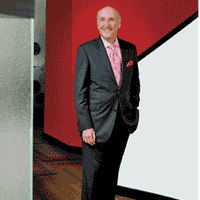Memories of days past draw baby boomers to A&W franchises across the country
Franchise Excellence of The Year
Looked at through the prism of today’s over-technified everything, the 1950s were particularly quaint. Slang-slinging teenagers did “the backseat bingo” (kissed in their cars), avoided “big daddy” the killjoy (an older person) and “goosed it” (accelerated the car) to evade “the heat” (the cops). Soon enough, they drove their duckbill hairdos and poodle skirts to an A&W carhop for root beer and onion rings deposited door-side.
While this charming version of youth is long gone, A&W — where you can devour a whole family of burgers, including a Teen, Mama, Papa, Grandpa, Grandma and now a premium Uncle — still evokes the warm and fuzzies in its original fans, though they’re decidedly older. Those who defiantly goosed it around town are now baby boomers who can’t resist indulging in a Teen Burger now and again. Is there anything more powerful than memories of youth?
The popular franchise is the number-2 burger chain — behind McDonald’s — in Canada, growing in the past five years from 500 to 720 restaurants across the country. Not too shabby for an outfit that started as a root-beer distributor in 1919, before opening as a carhop restaurant in 1921 in Lodi, Calif. The first Canadian A&W opened in 1956 in Winnipeg. Today, the Vancouver-based QSR chain is operated by A&W Food Services of Canada with no corporate connection to the American brand.
Based on its fiscal health, the change seems to have been positive. A&W Food Services of Canada posted 27 consecutive quarters of same-store sales growth and is one of this country’s 50 best-managed companies, boasting a franchise relationship that is the envy of the industry. Moreover, the chain’s charitable initiatives are commendable. A major national sponsor of the MS Society, its “Cruisin’ for a Cause” campaign raised more than $700,000 for the charitable organization.
Franchising is fraught on both ends of the spectrum. An established brand has to be extremely careful about how its image is portrayed to the public. The franchisee, conversely, has to ensure he or she will be dealt a fair deal.
Graham Cooke is a 29-year veteran of A&W. Over the phone from Vancouver, the vice-president of Restaurant Excellence has the chipper voice of someone who is used to answering even the most inane questions with grace and patience. He offers a crash-course on the mechanics of franchising. The initial cost is $50,000, with a minimum investment of $700,000 while service fees and advertising amount to 2.5 per cent of net sales. “You meet the basic criteria in terms of hard work and financial means, and then you get dirty,” he says. “You go into training for two days, and you’re making the food and are up to you neck in mustard, serving customers and working in the hot kitchen,” he adds. “That follows a six-week intensive training with one of A&W’s best franchisees.”
A&W has four types of stores: freestanding, convenience, enclosed captive (it sounds ominous, but these are actually tucked into a gas station with drive-thru service) and a bright new concept called the urban restaurant; the first of its kind launched in Vancouver this year, with 15 more expected to open across Canada. Situated in densely populated areas (a new move for A&W) with high-pedestrian traffic, these snappy spaces have a polished interior with food and features to match: salads, grilled chicken sandwiches on whole wheat, free Wi-Fi, self-serve ordering kiosks and a green initiative that will see waste reduced by 5,000 lbs. per year through the use of eco-conscious packaging, including stainless steel cutlery and reusable french-fry baskets. Updated exhaust equipment will reduce power and gas usage by 30 per cent, while Energy Star fryers will provide an additional 45 per cent reduction.
But, according to Cooke the highest performers are the people who get to know customers and staff. “You have to like people and be able to motivate a team,” he says, when talking about what makes a good franchisee. This is particularly challenging with 18-to-25-year-old workers who are often in transitory periods of their lives.
At A&W, the elusive art of motivation starts with communication. The head office in Vancouver has always been supportive of its team. In the pre-Internet days of 1988, the progressive brand used an exchange Intranet that allowed franchisees to share ideas. “They talked about the business and how they managed things,” Cooke says, “It’s indicative of how much importance we place on communication. We’ve been in business for 53 years in Canada,” he says. “Our franchisees have learned over time we’re stronger together.”
Frank Zaid, a partner with Osler, Hoskin & Harcourt in Toronto, and one of this country’s top franchise lawyers, has had a 20-year relationship with A&W. Because the company was concentrated in Western Canada, he didn’t hear from them much until their multisite development agreement started taking a bigger bite of Ontario over the past two years. This is where an operator can open five A&Ws, for example, in five years, he explains.
“Typically, companies like A&W sell one franchise here and there to different people, but at some point their older franchisees want to grow,” Zaid says. “It’s good because they’re familiar with the brand. It’s easier than starting from scratch.”
Zaid is impressed by A&W’s relationships. “They are an extremely well-organized company. The head-office spirit and culture is different than other companies,” he says. “They have an open and involved management team.” He continues, “They have a code of ethics they all subscribe to with suppliers and franchisees and are very honourable.”
But, really, it comes down to food; even the company lawyer, Zaid, is quick to emphasize A&W quality: “They don’t sell cheap hamburgers. Theirs are made with first-grade meat.” Indeed, consistent premium food is key to the operation. Its famous crunchy, misshapen and undeniably delectable onion rings, for instance, are hand-cut and battered at the stores — highly unusual in the QSR sector. “They’re sublime,” Cooke gushes. “We’d lose brand cred if we did it any other way.” Ditto for the draft root beer, served old-school in a frosty glass mug.
“You’ll never find wraps or fajitas on our menu,” Cooke says, eschewing the gimmicky and the trendy. “We’re a burger chain, and we’re proud of it,” he offers, when asked how A&W stays relevant. “We’re more expensive, but our food is better.” Additionally, the brand doesn’t target children in its advertising —“we never have and we never will,” Cooke says — but instead it is focused on its heritage connection, which shows in its commercials, in which Allen, a sweet fictional A&W manager, connects with boomers. “We made our brand in small-town Canada during the drive-in era,” Cooke says.
Ontario franchisee Steven Will owns six A&W restaurants across the province — a seventh is opening in the spring — and attests to his customers’ allegiance: “If I had a nickel for every time I’ve heard, ‘I remember when or, I went with my wife on our first date to an A&W,’ I wouldn’t need to open another restaurant,” he says.
The employee culture is superlative at A&W, Will continues. Every restaurant has climate meetings twice a year with all their staff. “They do this up the chain, even in head office,” he says. “Climate is embodied in a set of goals such as listening, respect, challenging each other — working together to be more profitable.
“The brand’s appeal is in its history. It’s something no other fast-food chain can draw upon. People remember coming to the A&W in the ’60s when they were younger and showing off their cars,” Will says.
These are the boomers whose duck-bill hairdos have receded and gone gray; their poodle skirts replaced with more practical attire; their children raising children of their own. But it’s nice to know, for a few hours, anyway, some things like the Teen Burger and a frosty mug of root beer always stay the same.
photography by lurenda mastromonaco





















